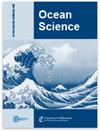On the short-term response of entrained air bubbles in the upper ocean: a case study in the north Adriatic Sea
IF 4.1
3区 地球科学
Q2 METEOROLOGY & ATMOSPHERIC SCIENCES
引用次数: 0
Abstract
Abstract. Air bubbles in the upper ocean are generated mainly by waves breaking at the air–sea interface. As such, after the waves break, entrained air bubbles evolve in the form of plumes in the turbulent flow, exchange gas with the surrounding water, and may eventually rise to the surface. To shed light on the short-term response of entrained bubbles in different stormy conditions and to assess the link between bubble plume penetration depth, mechanical and thermal forcings, and the air–sea transfer velocity of CO2, a field experiment was conducted from an oceanographic research tower in the north Adriatic Sea. Air bubble plumes were observed using high-resolution echosounder data from an upward-looking 1000 kHz sonar. The backscatter signal strength was sampled at a high resolution, 0.5 s in time and 2.5 cm along the vertical direction. Time series profiles of the bubble plume depth were established using a variable threshold procedure applied to the backscatter strength. The data show the occurrence of bubbles organized into vertical plume-like structures, drawn downwards by wave-generated turbulence and other near-surface circulations, and reaching the seabed at 17 m depth under strong forcing. We verify that bubble plumes adapt rapidly to wind and wave conditions and have depths that scale approximately linearly with wind speed. Scaling with the wind–wave Reynolds number is also proposed to account for the sea-state severity in the plume depth prediction. Results show a correlation between measured bubble depths and theoretical air–sea CO2 transfer velocity parametrized with wind-only and wind/wave formulations. Further, our measurements corroborate previous results suggesting that the sinking of newly formed cold-water masses helps bring bubbles to greater depths than those reached in stable conditions for the water column. The temperature difference between air and sea seems sufficient for describing this intensification at the leading order of magnitude. The results presented in this study are relevant for air–sea interaction studies and pave the way for progress in CO2 gas exchange formulations.海洋上层夹带气泡的短期反应:北亚得里亚海案例研究
摘要海洋上层的气泡主要是在海气界面破浪时产生的。因此,破浪后,夹带的气泡在湍流中以羽流的形式演化,与周围的海水进行气体交换,并可能最终上升到海面。为了了解夹带气泡在不同风暴条件下的短期反应,并评估气泡羽流穿透深度、机械和热作用力以及二氧化碳的海气传输速度之间的联系,我们在北亚得里亚海的一座海洋研究塔上进行了实地实验。使用上视 1000 千赫声纳的高分辨率回声测深仪数据对气泡羽流进行了观测。对反向散射信号强度进行了高分辨率采样,采样时间为 0.5 秒,采样垂直方向为 2.5 厘米。利用适用于反向散射强度的可变阈值程序,建立了气泡羽流深度的时间序列剖面图。数据显示,在波浪产生的湍流和其他近海面环流的作用下,气泡形成了垂直的羽状结构,并在强力作用下到达 17 米深的海底。我们验证了气泡羽流能够迅速适应风浪条件,其深度与风速近似线性相关。我们还提出了与风-波雷诺数成比例的方法,以解释在预测羽流深度时海况的严重性。结果表明,测量到的气泡深度与以纯风和风/波公式为参数的理论海气二氧化碳传输速度之间存在相关性。此外,我们的测量结果还证实了之前的研究结果,即新形成的冷水团下沉有助于将气泡带到比水柱稳定条件下所达到的更深的深度。空气和海水之间的温差似乎足以描述这种强化的主要数量级。本研究提出的结果与海气相互作用研究相关,并为二氧化碳气体交换配方的进展铺平了道路。
本文章由计算机程序翻译,如有差异,请以英文原文为准。
求助全文
约1分钟内获得全文
求助全文
来源期刊

Ocean Science
地学-海洋学
CiteScore
5.90
自引率
6.20%
发文量
78
审稿时长
6-12 weeks
期刊介绍:
Ocean Science (OS) is a not-for-profit international open-access scientific journal dedicated to the publication and discussion of research articles, short communications, and review papers on all aspects of ocean science: experimental, theoretical, and laboratory. The primary objective is to publish a very high-quality scientific journal with free Internet-based access for researchers and other interested people throughout the world.
Electronic submission of articles is used to keep publication costs to a minimum. The costs will be covered by a moderate per-page charge paid by the authors. The peer-review process also makes use of the Internet. It includes an 8-week online discussion period with the original submitted manuscript and all comments. If accepted, the final revised paper will be published online.
Ocean Science covers the following fields: ocean physics (i.e. ocean structure, circulation, tides, and internal waves); ocean chemistry; biological oceanography; air–sea interactions; ocean models – physical, chemical, biological, and biochemical; coastal and shelf edge processes; paleooceanography.
文献相关原料
| 公司名称 | 产品信息 | 采购帮参考价格 |
|---|
 求助内容:
求助内容: 应助结果提醒方式:
应助结果提醒方式:


